| Dandelion seed head |
| University of Bristol Botanic Garden |
young people seem to be committed to green ways; this problem arose through successive generations and perhaps it can be cured in the same way, the passing down of knowledge as we go.

University of Bristol Botanic Garden
Lose yourself in the world of plants…
| Dandelion seed head |
| University of Bristol Botanic Garden |
young people seem to be committed to green ways; this problem arose through successive generations and perhaps it can be cured in the same way, the passing down of knowledge as we go.
 |
| The stark landscape of Svalbard Photo credit: Paul Williams [via Flickr CC BY-NC 2.0] |
 |
| Svalbard Global Seed Vault Photo credit: Amber Case [via Flickr CC BY-NC 2.0] |
 |
| The metal shelves inside the Global Seed Vault. Photo credit: Dag Terje Filip Endresen [via Flickr CC BY-NC 2.0] |
Researchers at the University of Exeter‘s Penryn campus have had a comprehensive look at Japanese knotweed (Fallopia japonica) guidance from a range of sources on the web, including government sites, environmental NGOs, weed control companies, the media and the property market. They’ve found that this advice is often contradictory and even misleading.
 |
| A Japanese knotweed contaminated area in Hertfordshire is identified with signage. Photo credit: Peter O’Connor via Flickr [CC By-SA 2.0] |
 |
| Japanese knotweed growing along a fence in East London. Photo credit: Gordon Joly via Flickr [CC licence BY-SA 2.0] |
 |
| Svalbard Global Seed Vault, Norway. Photo credit: Amber Case [via Flickr CC licence] |
Seed banks – facilities that specialise in collecting and storing seeds that society has deemed worthy of cultivation – are critical in preserving and potentially restoring the plants lost as a result of war. In 2015, researchers made the first ever withdrawal of 38,000 seed samples from such a bank in order to rebuild a seed collection to replace one lost to the conflict in Syria.
 |
| One of the many ‘Dig for Victory’ posters of the Second World War. |
War also pushes the agricultural and manufacturing boundaries in the production of food and plant materials. One major commodity during the Second World War of vital importance was rubber. Natural rubber supplies from the plantations of Southeast Asia were severed at the start of the war and American forces were faced with the loss of a hugely important resource even though rubber had been stockpiled in the years preceding the war. With the fall of Singapore and the Dutch East Indies in 1942, rubber exports came to a complete standstill. The Americans invested heavily into developing synthetic rubber, but one of the twentieth century’s greatest ethnobotanists, Professor Richard Evans Schultes, was sent into the remote Amazon basin to hunt for wild rubber. For Schultes, this resulted in 12 years of exploratory research deep within the rainforest.
A recent talk to the Friends by Dr Chris Thorogood on the flora of the western Mediterranean was tonic for those of us longing for warmer weather. For Chris, the western Mediterranean has always had great appeal having spent many summers teaching field courses to undergraduate students at the University of Bristol and the last five years conducting fieldwork for his new book, a field guide to the area.
“The flora of the Western Mediterranean is really special. The plants are able to grow in some fascinating but really harsh places,” explains Chris. “Because of these severe conditions, plants have evolved numerous coping mechanisms in order to survive.”
The region is extremely rich botanically, with over 10,000 different species, all of which are specially adapted to particularly taxing conditions. The area covers a huge geographical expanse incorporating the westerly Portuguese Algarve, to Italy in the east, the islands (Balearic Islands, Corsica and Sardinia) and North Africa from Morocco to Tunisia (see my post last week, which discusses these regions in more detail).
There is a diverse range of floral habitats in the region from the scrubby maquis to forests with wonderful understories of orchids. The bare and arid habitats are home to ‘experts’ in drought tolerance; and at the other end of the watery spectrum are the seasonal lakes where deadly predatory plants reside. Humans have shaped the flora as well through thousands of years of agriculture, which has produced a visually evocative landscape throughout the whole Mediterranean basin.
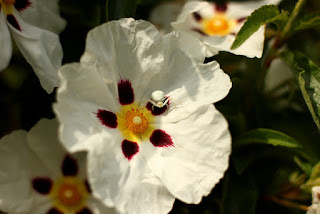 |
| Cistus ladanifer, the common gum cistus. Photo credit: Henry Bush [via Flickr, CC] |
A habitat that we so often associate with the Mediterranean landscape is maquis, which is specific to the Mediterranean area. It is comprised of spiny sclerophyllous (a fancy word for hard-leafed) tough vegetation, which is specially adapted to cope with severe drought. There are often small trees and shrubs dotted about, often with beautiful understories of bulbs and short-lived annuals. Many of the species are aromatic. Typical species include prickly juniper (Juniperus oxycedrus) and common gum cistus (Cistus ladanifer), both highly pungent plants that are used by the cosmetic industry for their oils.
“The smells that exude from maquis vegetation are wonderful,” exclaims Chris, “and the scent from these aromatic plants just seems to hang on your clothes long afterwards.”
Garrigue vegetation is similar to that of maquis. It differs slightly in that it is low growing in form, occurs closer to the coasts and grows on shallower soils. Due to its close proximity to the coast it is battered by winter storms and winds. The low stature of the garrigue evergreen scrub means that perennials and bulbs are highly visible. The flowering displays in spring are visually spectacular and include wild tulips, crocuses, thymes, mints, helichrysums and lavenders.
The native forests of the western Mediterranean form prominent landscapes occupying quite different terrain than the shrubland regions. The oak woodlands are dominated by the holm and cork oak, with a spectacular understory that offers a refuge for many animals, including the endangered Iberian lynx.
The pine forests of Pinus halepensis and Pinus pinaster occupy coasts and cliffs. Healthy habitats have a particularly distinctive flora and fauna with rarities such as the semi-parasitic Violet Limadore orchid found in the maritime pine forest of Landes in France.
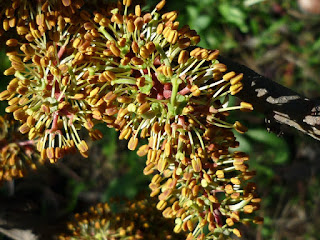 |
| Ceratonia siliqua, commonly known as the carob tree. Photo credit: Jesus Cabrera [via Flickr, CC] |
Humans have also shaped the forest landscapes of the region to a certain degree. Traditional farming practices in the Mediterranean have created unique assemblages of plants. Olive, carob, fig and almond groves represent landscapes people often associate with the Mediterranean. No other landscape denotes the true essence of the Mediterranean like a grove of olives. The olive is engrained in the lives and culture of the people of the region. Carob groves are also stunning in their composition with the gnarly dark trunks contrasting brilliantly against the green understory. The carob, Ceratonia siliqua, is a member of the ‘peas’ (Fabaceae), the most speciose family in the Mediterranean.
Most of the western Mediterranean habitats are dry and parched, but surprisingly there are some wet ecosystems too. These unusual habitats are rare and include some curious species like the carnivorous bladderworts, found in seasonal lakes, which catch insect prey using sticky hairs and trap doors.
“The aquatic habitats of the western Mediterranean are interesting because they are pretty rare,” explained Chris. “Many are only seasonal but they support a wealth of interesting species from tiny forget-me-nots, tongue orchids and the carnivorous bladderworts.”
While the native species of the western Mediterranean might be seen as tough and indestructible in the harsh landscapes they occupy, they are extremely susceptible to invasive alien species (IAS). Chris explained that the two most invasive plants in the region include certain species of Eucalyptus and Acacia. People assume these species are native, probably because they fit into the landscape visually and they can tolerate harsh climatic conditions. However, both these trees can alter native ecosystems and have a negative impact on biodiversity. Unfortunately, many are still planted as ornamental shrubs despite measures drawn up to prohibit the cultivation of them.
Chris explains the danger of one such exotic: “Acacia cyclops is an invasive species that is likely to become the next big invasive in the western Mediterranean. This species forms a mass of vegetation in barren landscapes due to its ability to cope with extremely dry and saline conditions. Ultimately it outcompetes native species.”
These invasive pests steal native plants’ water and change the biochemistry and microbiology of the soil. The native flora is sensitive because the western Mediterranean is exceptionally biodiverse in a relatively small area, with high levels of endemism, particularly on some of the islands. As well as the threat from IAS, there is also intense pressures on these fragile native habitats from humans due to urbanisation, afforestation, and coastal and agricultural development. Effective and timely conservation measures are vital to ensure the survival of these beautiful and botanically rich habitats before it is too late and they go into decline.
Helen Roberts is a trained landscape architect with a background in plant sciences. She is a probationary member of the Garden Media Guild and a regular contributor to the University of Bristol Botanic Garden blog.
 |
| The leaves of the Venus flytrap, open (foreground) and wrapped around its prey (background, right). Photo credit: Shelby Temple |
 |
| A close up view of the trap, which shows the sensory ‘hairs’. Photo credit: Shelby Temple |
As we roll into spring, gardeners eagerly collect packets of flower and vegetable seed to plant in their gardens. I have my disorganised pile of seeds ready and waiting, nestled in their respective packets, overflowing out of a tin stored on my kitchen dresser. Random seed that I have gleaned from gardens over the course of the year can be found in bags and random pockets.
 |
| Companion planting. Photo credit: Brian Pettinger courtesy of Flickr. |
My vegetable garden at home is minuscule and consists of a number of pots in the front and rear garden. I don’t own a greenhouse but use an area in my parent’s and beg ground from a friend to grow larger vegetables. Space is limited and therefore my crop is valuable. I don’t want attacks by cabbage white or carrot fly, I need to grow at different levels to maximise space and grow a wide range of small crops to give a varied meal. This has made me think more about what I can do to increase my crop productivity. I never use pesticides or herbicides in my garden and my resolve in this has been reinforced by recent press coverage over the importance of urban gardens for pollinators. I actually quite like cabbage white butterflies – my children do anyway – and they would be horrified if they knew I sprayed to rid the garden of them. Instead, I have decided to use the art of companion planting.
Companion planting is an age-old agricultural technique used for centuries across the world. It involves the idea of planting crops that are mutually beneficial to each other in order to increase productivity.
Companion planting has a very wide number of benefits and uses:
It is best not to put all of your eggs in one basket when growing crops – grow a mix of crops rather than a monoculture so if one crop fails you have other crops as a fall back option. Moreover, a mix of crops will make it more difficult for pests to find their host plants, a hypothesis known as the ‘disruptive-crop hypothesis’.
The other advantage is, if like me your garden is space constrained, you can plant on different levels. For example, a tall crop (such as corn) can provide a trellis support for a climbing crop (such as beans) and a ground crop (such as squash) provides shade and discourages weeds. You get three crops in a small amount of space and the companion plants provide physical advantages for the other crops.
Some plants provide shelter and shade for other plants; for example, the planting of corn can provide shade for lettuce or spinach (although most vegetable planting in this country requires as much sun as possible). Companion plants can also provide refuges for many beneficial insects.
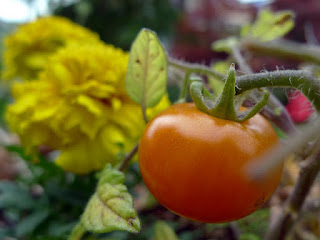 |
| Marigolds are supposed to help keep aphids away from tomato plants. Photo credit: Ruth Hartnup (on Flickr). |
Companion planting is also supposedly helpful in pest suppression through the release of repellent chemicals. Numerous companion plants also attract beneficial insects, such as ladybirds and lacewings, which predate on crop pests and many of these insects also act as important pollinators. Some plant species are used as ‘trap-crops’ drawing the attention of pests away from the crop and acting as sacrificial plants. Companion plants also provide a visual distraction to pests. In a monoculture, pests move easily from one plant to another, but companion plants break up this assault.
It is hard to know whether some traditional planting combinations that have endured the decades are based on any sound evidence of benefits. Certainly there is plenty of information about companion planting in the popular press and gardening books, but most is not backed up by any rigorous scientific trials in the peer reviewed literature. In academic literature, experimental results investigating the use of certain companion plants are varied as to their effectiveness. Here are some examples that I have come across:
I learned from my maternal grandfather to plant Allium species in amongst my carrot rows to help deter the pesky carrot fly, Psila rosae. This annoying pest feeds not only on the roots of carrots but also on other crops too including parsnip, celery, parsley and celeriac. The small 9 mm creamy white maggots cause scarring of the tap roots making them inedible and more prone to secondary rots. This year I plan to plant my carrots in amongst garlic chives, a plant similar to the onion chive and which also produces pretty white edible flowers.
It is generally thought that aromatic species deter pests by exuding repellent chemicals. Most relevant to the carrot-allium combination was a study that looked at mixed cropping of onion and carrots and the effects on pests of these crops. They found that there were reduced attacks by carrot fly compared to monocultures of both crops and that when the plants were planted together in high densities this also reduced plant pests and increased predators of carrot fly eggs. Stan Finch and his colleagues from Horticulture Research International in Warwick found no evidence that odours from aromatic plants repel or deter crop pests, suggesting that reduced attacks on host plants were a result of other mechanisms, such as simple disruptive effect.
I am not a big fan of Tagetes species, more commonly known as marigolds. They just remind me of old fashioned bedding plants in staid Victorian parks, but if they ward off pests in the vegetable plot then I am willing to use them. Tagetes sp. exude a strong odour that is apparently not pleasant for plant pests. They are supposedly useful to plant with tomatoes to ward off greenfly but I have yet to find any scientific literature to support this planting combination. Again, Finch and his associates specifically found that it was not the odour of the marigolds that repelled the pests, but simply the fact that they acted as a diversion for the pests.
I often grow pots of nasturtium (Tropaeolum majus) in my garden. I like the look of the flowers and especially the leaves, using them as salad garnishes and the seed to make capers. This plant is said to help attract black fly, aphids and other pests away from host plants acting as a crop trap and functioning as a sacrificial plant. There are mixed results as to whether nasturtiums really do this. One year in my garden I grew cabbage and nasturtium together and both crops were smothered in cabbage white caterpillars. The butterflies definitely did not show a preference for the Nasturtium and the caterpillars eventually obliterated both plants. Certainly there is not a wide range of recent academic literature investigating the use of nasturtiums as a companion plant. However, according to the Royal Horticultural Society (RHS), this plant is beneficial to pollinators and as I can also eat it, I plan to trial a variety known as Blue Pepe, known for its distinctive bluish leaves and bright red flowers.
The scientific literature on many companion plant combinations is mixed, but what is clear is that there are no disadvantages to using companion planting. The physical advantages of companion planting will be evident even if the other benefits are less obvious, and many companion plants can be found in the RHS’s ‘Perfect for Pollinators plant list‘. Even if you don’t get increased crop productivity, then the garden will be diverse and look beautiful too.
Helen Roberts is a trained landscape architect with a background in plant sciences. She is a probationary member of the Garden Media Guild and a regular contributor to the University of Bristol Botanic Garden blog.
Associate Professor Jane Mt. Pleasant
Uvah, I. I. I. and Coaker, T. H. Effect of mixed cropping on some insect pests of carrots and onions. Entomologia Experimentalis et Applicata 1984; 36: 159-167
Finch, S., Billiald, H. and Collier, R. H. Companion planting-do aromatic plants disrupt host-plant finding by the cabbage root fly and the onion fly more effectively than non-aromatic plants? Entomologia Experimentalis et Applicata 2003; 109: 183-195
The fossil record suggests that a diversity of land plants had evolved by about 472 million years ago (mya). There is evidence to suggest that plants made the move onto land as much as 700 mya [1], placing them in the midst of the five largest extinction events to have shaped life on our planet.
Researchers from the University of Gothenburg released a study earlier this year showing that plants have generally been more resilient to these extinction events than animals. They looked at more than 20,000 plant fossils to see how these mass extinction events affected plant diversity [2].
 |
| Ferns and horsetails dominated the landscape by the end of the Devonian. Credit: Nicola Temple |
They found, not unexpectedly, that each group of plants fared differently through each extinction event – with some doing better than others. Though plants might experience mass extinctions, the researchers concluded that plants also began to diversify again quickly after such events, so that more new species were being generated than were being lost.
“In the plant kingdom, mass extinction events can be seen as opportunities for turnover leading to renewed biodiversity,” said leading author Daniele Silvestro.
Scientists have identified five mass extinction events since land plants have evolved.
Ordovician – Silurian mass extinction (approximately 443 mya): This event wiped out approximately 85% of sea-dwelling creatures, such as trilobites. It has been hypothesised that a huge ice sheet in the southern hemisphere led to the alteration of climate patterns, a drop in the sea-level and a change in ocean chemistry.
Late Devonian (approximately 359 mya): This event is likely a series of smaller extinction events that happened over several million years, but the end result was a loss of 75% of all species on Earth. Changes in sea level, multiple asteroid impacts and new plants that were changing the soil chemistry have all been attributed to this period of extinction.
Permian (approximately 248 mya): It is estimated that 96% of all species were wiped out during this mass extinction. Marine creatures were badly affected and it is the only extinction thought to have had an impact on insects. Hypotheses as to what led to the demise of so many creatures have included combinations of asteroid impacts, volcanic activity, methane releases and decreased oxygen levels.
Triassic – Jurassic (approximately 200 mya): A mere fifty million years after the Permian extinction, about fifty percent of life was wiped out again. Plants seem to have been largely unaffected by this extinction event, but many of the marine reptiles were lost as well as large amphibians and cephalopod molluscs. Large scale volcanic activity and asteroid impacts have both been credited for these extinctions.
 |
| This dinosaur can still be spotted in the Evolutionary Dell at the Botanic Garden! Credit: Nicola Temple |
Cretaceous – Paleogene (approximately 65 mya): This extinction event is well known for the loss of the dinosaurs, pterosaurs and ammonites. The prevailing theory for this extinction is the impact of a large asteroid off the coast of Yucatán, Mexico and the subsequent fall-out effects.
While each of these mass extinction events meant the widespread loss of species, they also opened up opportunities for diversification and new species. Had the dinosaurs not gone extinct, for example, mammals would likely not have diversified, compromising our own lineage as humans. Flowering plants experienced extensive diversification after the Cretaceous – Paleogene event and they remain a dominant group today.
 |
| The Wollemi Pine (Wollemia nobilis) on display at the Botanic Garden has fossils dating back 200 million years. Credit: Nicola Temple |
The majority of plants have undergone one or more duplication events where an exact copy of their entire genome is created. This is known as polyploidy – multiple copies of the same genome. Bread wheat, as an example, is hexaploid as it has six sets of chromosomes. Research has shown that one of these doubling events coincides with the Cretaceous – Paleogene mass extinction, approximately 65 million years ago[3].
An extra set of chromosomes could be quite convenient during a prolonged period of stress, such as a massive asteroid strike and its subsequent effects. Polyploids might be better equipped to resist harmful mutations or perhaps take on mutations that offer a selective advantage under new conditions. Polyploidy plants also tend to be self-fertilising or asexual reproducers, which would be another advantage at a time when finding a partner for breeding could be limited.
The theory that polyploidy confers an advantage during times of change can be witnessed in today’s extreme environments. There is evidence from the Arctic that polyploid plants are more successful than diploid plants at colonising habitats left by receding glaciers [3].
 |
| The Evolution of Land Plants Display at the Botanic Garden (wrapped up for winter) is a walk through time. Credit: Nicola Temple |
Looking into extreme and changing habitats, such as the Arctic, as well as back into the fossil record can give us some indications of which plant groups may be more resilient to the changing climate we are currently experiencing.
You can take a walk through time in the University of Bristol Botanic Garden’s Evolution of Land Plants Display. There you will see living representatives from the groups of land plants that lived from the Cambrian to the Cretaceous, including unusual plants like Wollemi Pine (Wollemia nobilis) with fossils dating back 200 million years.
[1] ‘First land plants and fungi changed Earth’s climate, paving the way for explosive evolution of land animals, new gene study suggests’, Penn State Science < http://science.psu.edu/news-and-events/2001-news/Hedges8-2001.htm>
[2] Silvestro D, Cascales-Miñana B, Bacon CD, Antonelli A (2015). Revisiting the origin and diversification of vascular plants through a comprehensive Bayesian analysis of the fossil record. New Phytologist (in press).
[3] Yong E (23 Mar 2009) ‘Extra genomes helped plants to survive extinction event that killed dinosaurs’, Not Exactly Rocket Science [blog] <http://scienceblogs.com/notrocketscience/2009/03/23/extra-genomes-helped-plants-to-survive-extinction-event-that/>
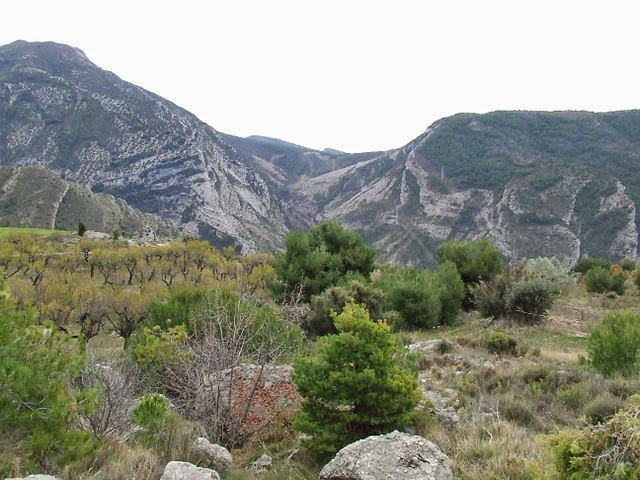 |
| Maquis shrubland in Conca de Dalt of Catalonia, northeastern Spain. Photo by Gustau Erill i Pinyot. Licensed under CC BY-SA 3.0 via Wikimedia Commons |
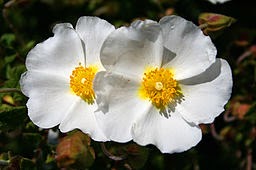 |
| Montpelier cistus (Cistus monspeliensis). Photo by Jean-Pol GRANDMONT via Wikimedia Commons |
 |
| A closed cone and foliage of Pinus pinea. Licensed under CC BY-SA 2.5 es via Wikimedia Commons |
 |
| Part of Cheddar Gorge, Somerset, England, seen from a light aircraft. Photo by Adrian Pingstone (1975). |
 |
| Cheddar Pink (Dianthus gratianopolitanus). Photo by Paul Harvey, via Wikimedia Commons |